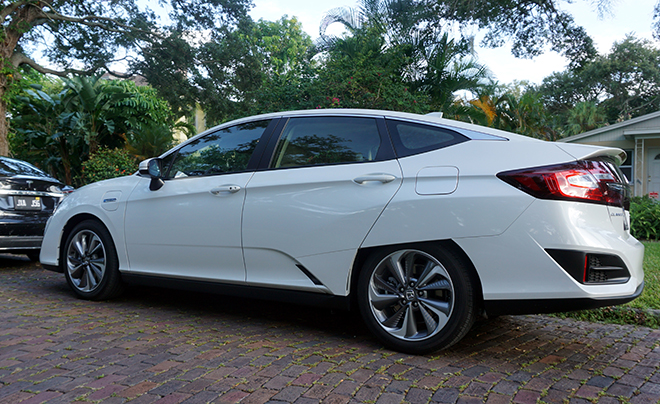The Honda Clarity Plug-In Hybrid is a quiet star. While the Tesla Model 3 and Chevy Volt have been hogging the headlines, the Clarity PHEV has sold 8,109 units in the US since its late 2017 launch. It’s the third best-selling PHEV on the market, after the Prius Prime and the Chevy Volt.
In the latest issue of Charged, you can read about our discussion with a couple of Honda execs about the Clarity and how it fits in with the company’s rejuvenated electrification strategy. Meanwhile, I got to drive the new PHEV for a week, and was thoroughly impressed.
As long-time readers know, I am no expert on acceleration, cornering and the rest of the car guy stuff – I’ll leave the technical assessments of the Clarity’s performance to my colleagues at Car and Driver, Kelley Blue Book, Autoblog et al. And I’m an EV guy – I’m hooked on that instant-torque leap that an electric motor delivers up to 30 or 40 mph. The Clarity PHEV has a lovely leap – the gas burner kicks in only when you push the pedal down all the way – and the 47-mile electric range means you’ll get to enjoy it for most of your trip.


Lacking the vocabulary of the test track, all I can do is compare performance among models that I’ve recently driven. I found the driving experience of the Clarity PHEV to be excellent, on a par with the Prius Prime Advanced, far superior to the Kia Niro PHEV and, needless to say, superior to any plain (non-plug-in) hybrid.
At the moment, only Tesla and Cadillac claim to offer something close to self-driving capability (Level 2 automation), but autonomy is gradually creeping into many high-end vehicles. The Clarity PHEV Touring has adaptive cruise control and lane-keeping assist, and with both of these enabled, you will find the car “driving itself” from time to time (the same is true of the upper-trim Kia Niro PHEV). The vehicle will speed up and slow down to keep pace with the car ahead, and it will occasionally take the wheel and navigate turns on its own. However, these systems are inconsistent and unpredictable. The Honda’s ACC sometimes slows down when it shouldn’t, apparently mistaking a car in another lane for one ahead, and I never could figure out what triggered the lane-keeping assist – sometimes it took the wheel on a curve, but most times it didn’t. Whereas Tesla’s Autopilot is a pretty reliable chauffeur most of the time, the systems found on the Honda and the Kia are not (nor do they claim to be). However, in certain circumstances they might very well help to prevent a crash.


And what about my personal hobby horse, cargo space? In this department, the Clarity isn’t a contender (although the PHEV does offer more space than the pure EV and hydrogen variants). It’s a sedan, and sedans simply aren’t designed to haul more than a couple of suitcases or a few grocery bags. One thing that’s interesting is that the Clarity’s rear cargo area is very similar to that of Tesla’s Model 3. A stubby trunk lid opens to reveal a moderate-size cargo space. A six-inch liftover makes loading heavy objects impractical, but the rear seats fold down, revealing a handy pass-through hole that allows you to load long objects like skis (or microphone stands).


If a sedan is what you want, and you aren’t prepared to pay the premium price of a Tesla, I think you’ll be delighted with the Honda Clarity PHEV.
- Battery: 17 kWh
- Engine: 1.5 liters, 103 hp
- Motor: AC permanent-magnet synchronous, 181 hp
- Fuel economy: 110 MPGe; 42 MPG combined
- Electric range: 47 miles
- MSRP: Plug-In Hybrid $33,400; Touring $36,600. Eligible for $7,500 federal tax credit.


















































